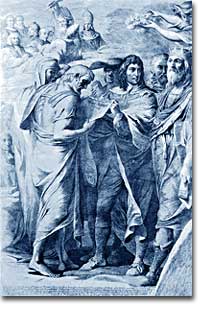5a. Maryland — The Catholic Experiment

New England was not the only destination sought by those fleeing religious persecution. In 1632, Cecelius Calvert, known as Lord Baltimore, was granted possession of all land lying between the Potomac River and the Chesapeake Bay. Lord Baltimore saw this as an opportunity to grant religious freedom to the Catholics who remained in Anglican England. Although outright violence was more a part of the 1500s than the 1600s, Catholics were still a persecuted minority in the seventeenth century. For example, Catholics were not even permitted to be legally married by a Catholic priest. Baltimore thought that his New World possession could serve as a refuge. At the same time, he hoped to turn a financial profit from the venture.
Maryland, named after England's Catholic queen Henrietta Maria, was first settled in 1634. Unlike the religious experiments to the North, economic opportunity was the draw for many Maryland colonists. Consequently, most immigrants did not cross the Atlantic in family units but as individuals. The first inhabitants were a mixture of country gentlemen (mostly Catholic) and workers and artisans (mostly Protestant). This mixture would surely doom the Catholic experiment. Invariably, there are more poor than aristocrats in any given society, and the Catholics soon found themselves in the minority.
The geography of Maryland, like that of her Southern neighbor Virigina, was conducive to growing tobacco. The desire to make profits from tobacco soon led to the need for low-cost labor. As a result, the number of indentured servants greatly expanded and the social structure of Maryland reflected this change. But the influx in immigration was not reflected in larger population growth because, faced with frequent battles with malaria and typhoid, life expectancy in Maryland was about 10 years less than in New England.
Fearful that the Protestant masses might restrict Catholic liberties, the House of Delegates passed the Maryland Act of Toleration in 1649. This act granted religious freedom to all Christians. Like Roger Williams in Rhode Island and William Penn in Pennsylvania, Maryland thus experimented with laws protecting religious liberty. Unfortunately, Protestants swept the Catholics out of the legislature within a decade, and religious strife ensued. Still, the Act of Toleration is an important part of the colonial legacy of religious freedom that will culminate in the First Amendment in the American Bill of Rights.






